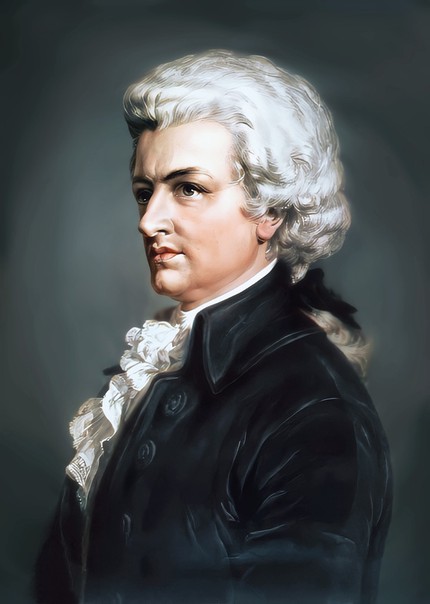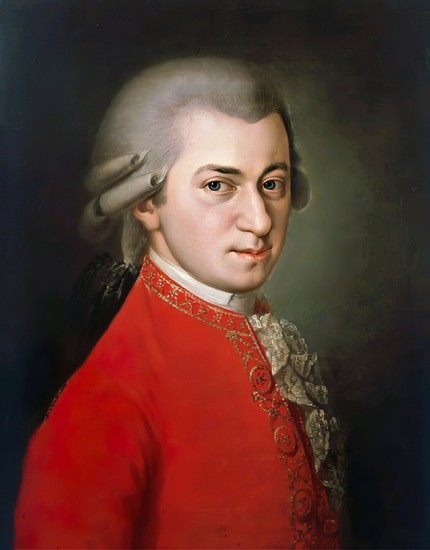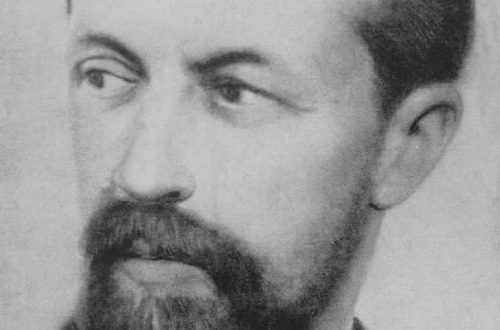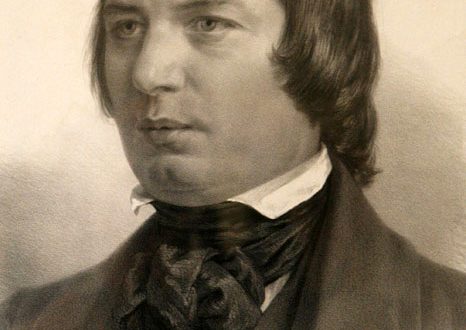
Wolfgang Amadeus Mozart |
Wolfgang Amadeus Mozart

In my deep conviction, Mozart is the highest, culminating point, to which beauty has reached in the field of music. P. Tchaikovsky
“What depth! What courage and what harmony! This is how Pushkin brilliantly expressed the essence of Mozart’s brilliant art. Indeed, such a combination of classical perfection with boldness of thought, such an infinity of individual decisions based on clear and precise laws of composition, we will probably not find in any of the creators of musical art. Sunny clear and incomprehensibly mysterious, simple and immensely complex, deeply human and universal, cosmic appears the world of Mozart’s music.
W. A. Mozart was born in the family of Leopold Mozart, a violinist and composer at the court of the Salzburg archbishop. Genius talent allowed Mozart to compose music from the age of four, very quickly master the art of playing the clavier, violin, and organ. The father skillfully supervised the studies of his son. In 1762-71. he undertook tours, during which many European courts got acquainted with the art of his children (the eldest, sister of Wolfgang was a gifted clavier player, he himself sang, conducted, played various instruments virtuoso and improvised), which everywhere caused admiration. At the age of 14, Mozart was awarded the papal order of the Golden Spur, elected a member of the Philharmonic Academy in Bologna.
On trips, Wolfgang got acquainted with the music of different countries, mastering the genres characteristic of the era. So, acquaintance with J.K. Bach, who lived in London, brings to life the first symphonies (1764), in Vienna (1768) he receives orders for operas in the genre of the Italian buffa opera (“The Pretend Simple Girl”) and the German Singspiel (“ Bastien and Bastienne “; a year earlier, the school opera (Latin comedy) Apollo and Hyacinth was staged at the University of Salzburg. Especially fruitful was his stay in Italy, where Mozart improved in counterpoint (polyphony) with G. B. Martini (Bologna), puts in Milan, the opera seria “Mithridates, King of Pontus” (1770), and in 1771 – the opera “Lucius Sulla”.
The brilliant young man was less interested in patrons than the miracle child, and L. Mozart could not find a place for him at any European court in the capital. I had to return to Salzburg to perform the duties of the court accompanist. Mozart’s creative aspirations were now limited to orders for composing sacred music, as well as entertaining pieces – divertissements, cassations, serenades (that is, suites with dance parts for various instrumental ensembles that sounded not only at court evenings, but also on the streets, in the houses of Austrian townspeople). Mozart continued his work in this area later in Vienna, where his most famous work of this kind was created – “Little Night Serenade” (1787), a kind of miniature symphony, full of humor and grace. Mozart also writes concertos for violin and orchestra, clavier and violin sonatas, etc. One of the peaks of the music of this period is the Symphony in G minor No. 25, which reflected the rebellious “Werther” moods characteristic of the era, close in spirit to the literary movement “Storm and Onslaught” .
Languishing in provincial Salzburg, where he was held back by the despotic claims of the archbishop, Mozart made unsuccessful attempts to settle in Munich, Mannheim, Paris. Trips to these cities (1777-79), however, brought a lot of emotional (first love – to the singer Aloysia Weber, mother’s death) and artistic impressions, reflected, in particular, in the clavier sonatas (in A minor, in A major with variations and Rondo alla turca), in the Symphony Concerto for violin and viola and orchestra, etc. Separate opera productions (“The Dream of Scipio” – 1772, “The Shepherd King” – 1775, both in Salzburg; “The Imaginary Gardener” – 1775, Munich) did not satisfy the aspirations Mozart to regular contact with the opera house. The staging of the opera seria Idomeneo, King of Crete (Munich, 1781) revealed the full maturity of Mozart as an artist and man, his courage and independence in matters of life and creativity. Arriving from Munich to Vienna, where the archbishop went to the coronation celebrations, Mozart broke with him, refusing to return to Salzburg.
Mozart’s fine Viennese debut was the singspiel The Abduction from the Seraglio (1782, Burgtheater), which was followed by his marriage to Constance Weber (Aloysia’s younger sister). However (subsequently, opera orders were not received so often. The court poet L. Da Ponte contributed to the production of operas on the stage of the Burgtheater, written on his libretto: two of Mozart’s central works – “The Marriage of Figaro” (1786) and “Don Giovanni” (1788), and also the opera-buff “That’s what everyone does” (1790); in Schönbrunn (the summer residence of the court) a one-act comedy with music “Director of the Theater” (1786) was also staged.
During the first years in Vienna, Mozart often performed, creating concertos for clavier and orchestra for his “academies” (concerts organized by subscription among patrons of the arts). Of exceptional importance for the composer’s work was the study of the works of J. S. Bach (as well as G. F. Handel, F. E. Bach), which directed his artistic interests to the field of polyphony, giving new depth and seriousness to his ideas. This was very clearly manifested in the Fantasia and Sonata in C minor (1784-85), in six string quartets dedicated to I. Haydn, with whom Mozart had a great human and creative friendship. The deeper Mozart’s music penetrated into the secrets of human existence, the more individual the appearance of his works became, the less successful they were in Vienna (the post of court chamber musician received in 1787 obliged him only to create dances for masquerades).
Much more understanding was found by the composer in Prague, where in 1787 The Marriage of Figaro was staged, and soon the premiere of Don Giovanni written for this city took place (in 1791 Mozart staged another opera in Prague – The Mercy of Titus) , which most clearly outlined the role of the tragic theme in Mozart’s work. The Prague Symphony in D major (1787) and the last three symphonies (No. 39 in E-flat major, No. 40 in G minor, No. 41 in C major – Jupiter; summer 1788) marked the same boldness and novelty, which gave an unusually bright and full a picture of the ideas and feelings of their era and paved the way for the symphony of the XIX century. Of the three symphonies of 1788, only the Symphony in G minor was performed once in Vienna. The last immortal creations of Mozart’s genius were the opera The Magic Flute – a hymn to light and reason (1791, Theater in the Viennese suburbs) – and a mournful majestic Requiem, not completed by the composer.
The sudden death of Mozart, whose health was probably undermined by a prolonged overstrain of creative forces and difficult conditions of the last years of his life, the mysterious circumstances of the order of the Requiem (as it turned out, the anonymous order belonged to a certain Count F. Walzag-Stuppach, who intended to pass it off as his composition), burial in a common grave – all this gave rise to the spread of legends about the poisoning of Mozart (see, for example, Pushkin’s tragedy “Mozart and Salieri”), which did not receive any confirmation. For many subsequent generations, Mozart’s work has become the personification of music in general, its ability to recreate all aspects of human existence, presenting them in a beautiful and perfect harmony, filled, however, with internal contrasts and contradictions. The artistic world of Mozart’s music seems to be inhabited by a variety of characters, multifaceted human characters. It reflected one of the main features of the era, which culminated in the French Revolution of 1789, the life-giving principle (the images of Figaro, Don Juan, the symphony “Jupiter”, etc.). The affirmation of the human personality, the activity of the spirit is also connected with the disclosure of the richest emotional world – the variety of its inner shades and details makes Mozart the forerunner of romantic art.
The comprehensive character of Mozart’s music, which embraced all genres of the era (except for those already mentioned – the ballet “Trinkets” – 1778, Paris; music for theatrical productions, dances, songs, including “Violet” at the station of J. W. Goethe, masses , motets, cantatas and other choral works, chamber ensembles of various compositions, concertos for wind instruments with an orchestra, Concerto for flute and harp with an orchestra, etc.) and which gave them classical samples, is largely due to the huge role played in it interaction of schools, styles, eras and musical genres.
Embodying the characteristic features of the Viennese classical school, Mozart summarized the experience of Italian, French, German culture, folk and professional theater, various opera genres, etc. His work reflected the socio-psychological conflicts born of the pre-revolutionary atmosphere in France (libretto “The Marriage of Figaro “Written according to the modern play by P. Beaumarchais” Crazy Day, or The Marriage of Figaro”), the rebellious and sensitive spirit of German storming (“Storm and Onslaught”), the complex and eternal problem of the contradiction between the daring of man and moral retribution (“Don Juan”).
The individual appearance of a Mozart work is made up of many intonations and developmental techniques typical of that era, uniquely combined and heard by the great creator. His instrumental compositions were influenced by the opera, the features of symphonic development penetrated into the opera and the mass, the symphony (for example, the Symphony in G minor – a kind of story about the life of the human soul) can be endowed with the detailing characteristic of chamber music, the concerto – with the significance of the symphony, etc. The genre canons of the Italian buffa opera in The Marriage of Figaro flexibly submit to the creation of a comedy of realistic characters with a clear lyrical accent, behind the name “jolly drama” there is a completely individual solution to the musical drama in Don Giovanni, imbued with Shakespearean contrasts of comedy and sublimely tragic.
One of the brightest examples of Mozart’s artistic synthesis is The Magic Flute. Under the cover of a fairy tale with an intricate plot (many sources are used in the libre by E. Schikaneder), utopian ideas of wisdom, goodness and universal justice, characteristic of the Enlightenment, are hidden (the influence of Freemasonry also affected here – Mozart was a member of the “brotherhood of free masons”). The arias of Papageno’s “bird-man” in the spirit of folk songs alternate with strict choral melodies in the part of the wise Zorastro, the heartfelt lyrics of the arias of lovers Tamino and Pamina – with the coloratura of the Queen of the Night, almost parodying the virtuoso singing in Italian opera, the combination of arias and ensembles with colloquial dialogues ( in the tradition of the singspiel) is replaced by a through development in the extended finals. All this is also combined with the “magical” sound of the Mozart orchestra in terms of the mastery of instrumentation (with solo flute and bells). The universality of Mozart’s music allowed it to become the ideal of art for Pushkin and Glinka, Chopin and Tchaikovsky, Bizet and Stravinsky, Prokofiev and Shostakovich.
E. Tsareva

His first teacher and mentor was his father, Leopold Mozart, assistant Kapellmeister at the court of the Salzburg Archbishop. In 1762, his father introduces Wolfgang, still a very young performer, and his sister Nannerl to the courts of Munich and Vienna: the children play keyboards, violin and sing, and Wolfgang also improvises. In 1763, their long tour took place in southern and eastern Germany, Belgium, Holland, southern France, Switzerland, all the way to England; twice they were in Paris. In London, there is an acquaintance with Abel, J.K. Bach, as well as the singers Tenducci and Manzuoli. At the age of twelve, Mozart composed the operas The Imaginary Shepherdess and Bastien et Bastienne. In Salzburg, he was appointed to the post of accompanist. In 1769, 1771 and 1772 he visited Italy, where he received recognition, staged his operas and was engaged in systematic education. In 1777, in the company of his mother, he traveled to Munich, Mannheim (where he fell in love with the singer Aloisia Weber) and Paris (where his mother died). Settles in Vienna and in 1782 marries Constance Weber, sister of Aloysia. In the same year, his opera The Abduction from the Seraglio awaits great success. He creates works of various genres, showing amazing versatility, becomes a court composer (without specific responsibilities) and hopes to receive the post of second Kapellmeister of the Royal Chapel after Gluck’s death (the first was Salieri). Despite fame, especially as an opera composer, Mozart’s hopes did not come true, including because of gossip about his behavior. Leaves the Requiem unfinished. Respect for aristocratic conventions and traditions, both religious and secular, combined in Mozart with a sense of responsibility and an inner dynamism that led some to regard him as a conscious forerunner of Romanticism, while for others he remains the incomparable end of a refined and intelligent age, respectfully related to the rules and canons. In any case, it was precisely from the constant collision with various musical and moral clichés of that time that this pure, tender, imperishable beauty of Mozart’s music was born, in which in such a mysterious way there is that feverish, crafty, quivering that is called “demonic”. Thanks to the harmonious use of these qualities, the Austrian master – a true miracle of music – overcame all the difficulties of composition with knowledge of the matter, which A. Einstein rightly calls “somnambulistic”, creating a huge number of works that gushed out from under his pen both under pressure from customers and and as a result of immediate inner urges. He acted with the speed and composure of a man of modern times, although he remained an eternal child, alien to any cultural phenomena that were not related to music, completely turned to the outside world and at the same time capable of amazing insights into the depths of psychology and thought.
An incomparable connoisseur of the human soul, especially the female one (who conveyed its grace and duality in equal measure), perceptively ridiculing vices, dreaming of an ideal world, easily moving from the deepest sorrow to the greatest joy, a pious singer of passions and sacraments – whether these latter are Catholic or Masonic – Mozart still fascinates as a person, remaining the pinnacle of music in the modern sense. As a musician, he synthesized all the achievements of the past, bringing to perfection all musical genres and surpassing almost all his predecessors with a perfect combination of northern and Latin sentiments. In order to streamline Mozart’s musical heritage, it was necessary to publish in 1862 a voluminous catalog, subsequently updated and corrected, which bears the name of its compiler L. von Köchel.
Such creative productivity – not so rare, however, in European music – was not only the result of innate abilities (it is said that he wrote music with the same ease and ease as letters): within the short period allotted to him by fate and marked by sometimes inexplicable qualitative leaps, it was developed through communication with various teachers, which made it possible to overcome crisis periods in the formation of mastery. Of the musicians who had a direct influence on him, one should name (in addition to his father, Italian predecessors and contemporaries, as well as D. von Dittersdorf and J. A. Hasse) I. Schobert, K. F. Abel (in Paris and London), both the sons of Bach, Philipp Emanuel and especially Johann Christian, who was an example of the combination of “gallant” and “learned” styles in large instrumental forms, as well as in arias and opera series, K. V. Gluck – in terms of theater, despite on a significant difference in creative settings, Michael Haydn, an excellent counterpoint player, brother of the great Joseph, who, in turn, showed Mozart how to achieve convincing expression, simplicity, ease and flexibility of dialogue, without abandoning the most complex techniques. His trips to Paris and London, to Mannheim (where he listened to the famous orchestra conducted by Stamitz, the first and most advanced ensemble in Europe) were fundamental. Let us also point to the environment of Baron von Swieten in Vienna, where Mozart studied and appreciated the music of Bach and Handel; Finally, we note travels to Italy, where he met with famous singers and musicians (Sammartini, Piccini, Manfredini) and where in Bologna he took an exam in strict counterpoint from Padre Martini (to tell the truth, not very successful).
In the theater, Mozart achieved an unprecedented combination of Italian opera buffa and drama, achieving musical results of inestimable significance. While the action of his operas is based on well-chosen stage effects, the orchestra, like lymph, permeates every smallest cell of the character’s characteristics, easily penetrates into the smallest gaps within the word, like fragrant, lukewarm wine, as if for fear that the character will not have enough spirit. hold the role. The melodies of an unusual fusion are rushing in full sail, either forming legendary solos, or dressing in various, very careful outfits of ensembles. Under the constant exquisite balance of form and under the sharply satirical masks, one can see a constant aspiration to the human consciousness, which is hidden by a game that helps to master the pain and heal it. Is it possible that his brilliant creative path ended with a Requiem, which, although not completed and not always amenable to clear reading, although completed by an inept student, still shudders and sheds tears? Death as a duty and the distant smile of life appears to us in the sighing Lacrimosa, like the message of a young god taken from us too soon.
G. Marchesi (translated by E. Greceanii)
- List of compositions by Mozart →





